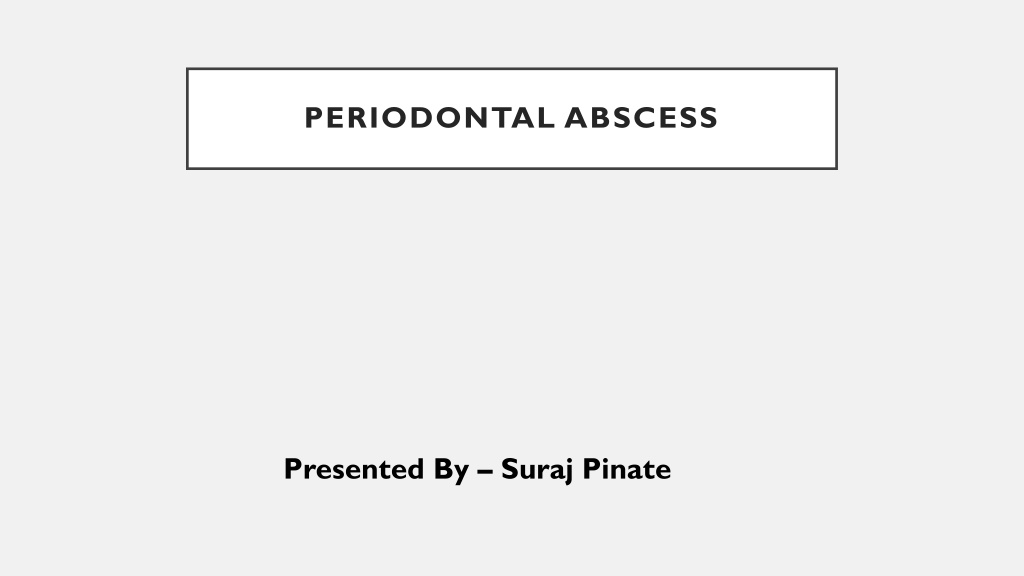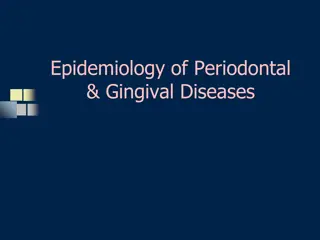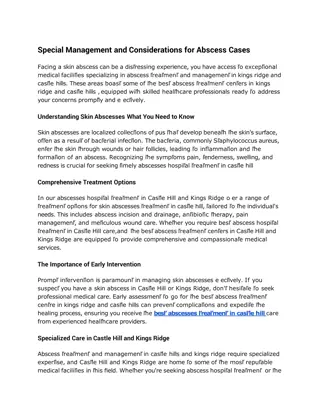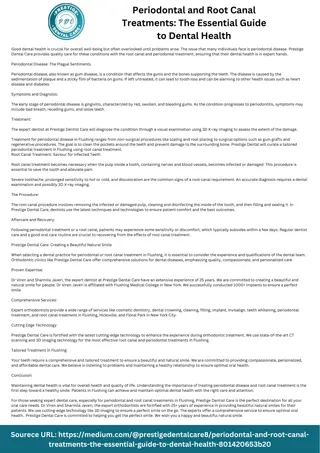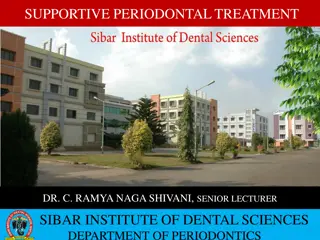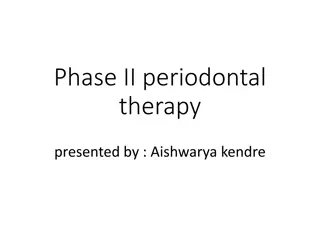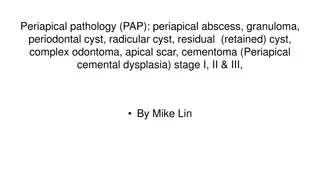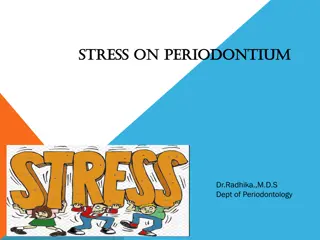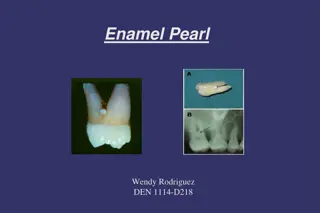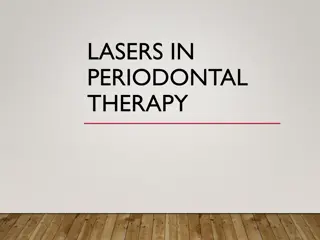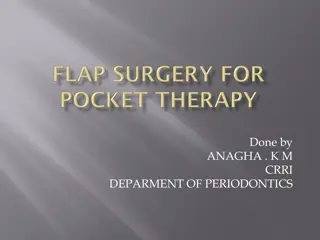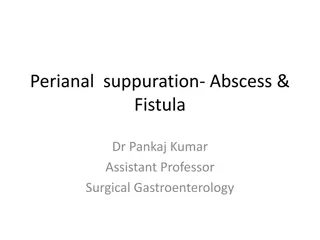PERIODONTAL ABSCESS Presented By
Periodontal abscesses are localized purulent inflammations in the periodontal tissues. They can result in destruction of ligaments and bone. Gingival abscesses are acute inflammatory lesions with various causes. Proper treatment is crucial to prevent complications like tooth loss.
Download Presentation

Please find below an Image/Link to download the presentation.
The content on the website is provided AS IS for your information and personal use only. It may not be sold, licensed, or shared on other websites without obtaining consent from the author.If you encounter any issues during the download, it is possible that the publisher has removed the file from their server.
You are allowed to download the files provided on this website for personal or commercial use, subject to the condition that they are used lawfully. All files are the property of their respective owners.
The content on the website is provided AS IS for your information and personal use only. It may not be sold, licensed, or shared on other websites without obtaining consent from the author.
E N D
Presentation Transcript
PERIODONTAL ABSCESS Presented By Suraj Pinate
ABSCESS The periodontal abscess is a localized purulent inflammation of the periodontal tissues. It has been classified into three diagnostic groups: gingival abscess, periodontal abscess, and pericoronal abscess. The gingival abscess involves the marginal gingival and interdental tissues.
The periodontal abscess is an infection located contiguous to the periodontal pocket and may result in destruction of the periodontal ligament and alveolar bone. The pericoronal abscess is associated with the crown of a partially erupted tooth.
GINGIVAL ABSCESS The gingival abscess is a localized acute inflammatory lesion that may arise from a variety of sources, including microbial plaque infection, trauma, and foreign body impaction. Clinical features include a red, smooth, sometimes painful, often fluctuant swelling
PERIODONTAL ABSCESS Periodontal abscesses are typically found in patients with untreated periodontitis and in association with moderate to deep periodontal pockets.1 Periodontal abscesses often arise as acute exacerbations of preexisting pockets. 2 Primarily related to incomplete calculus removal, periodontal abscesses have been linked to several clinical situations. 3
They have been identified in patients after periodontal surgery,1 after preventive maintenance, after systemic antibiotic therapy, 2 and as the result of recurrent disease. Conditions in which periodontal abscesses are not related to inflammatory periodontal disease include tooth perforation3 or and foreign body impaction.
Poorly controlled diabetes mellitus has been considered a predisposing factor for periodontal abscess formation. Formation of periodontal abscess has been reported as a major cause of tooth loss; however, with proper treatment followed by consistent preventive periodontal maintenance, teeth with significant bone loss may be retained for many years.
MICROBIOLOGY It has been reported that the microorganisms that colonize the periodontal abscesses are primarily Gram negative anaerobic rods. High frequencies of Porphyromonas gingivalis, Prevotella intermedia, Fusobacterium nucleatum, Campylobacter rectus, and Capnocytophaga spp have been reported. Actinobacillus actinomycetemcomitans is not usually detected. The disappearance of Porphyromonas gingivalis from the abscessed sites after treatment suggests a close association of this microorganism with abscess formation.
ACUTE V/S CHRONIC ABSCESS Abscesses are categorized as acute or chronic. The acute abscess is often an exacerbation of a chronic inflammatory periodontal lesion. Influencing factors include increased number and virulence of bacteria combined with lowered tissue resistance and lack of spontaneous drainage. The drainage may have been prevented by deep, tortuous pocket morphology, debris, or closely adapted pocket epithelium blocking the pocket orifice.
Acute abscesses are characterized by painful, red, edematous, smooth, and ovoid swelling of the gingival tissues. Exudate may be expressed with gentle pressure; the tooth may be percussion sensitive and feel elevated in the socket. Fever and regional lymphadenopathy are occasional findings.
The chronic abscess forms after the spreading infection has been controlled by spontaneous drainage, host response, or therapy. Once homeostasis between the host and infection has been reached, the patient may have few or no symptoms. However, dull pain may be associated with the clinical findings of a periodontal pocket, inflammation, and a fistulous tract.
PERIODONTAL V/S PULPAL To determine the cause of an abscess and thus establish a proper treatment plan, it is often necessary to perform a differential diagnosis between periodontal abscess and pulpal abscess. The correct diagnosis for these two lesions may overlap in some cases, but careful examination and patient questioning are important for an accurate diagnosis because the therapy for these two lesions is completely different.
TREATMENT The principles for the management of simple dental infections are as follows: 1. Local measures i. Drainage ii. Maintain drainage iii. Eliminate cause 2. Systemic measures in conjunction with the local measures
The management of a patient with periodontal abscess can divided into three stages: i. Immediate management ii. Initial management iii. Definitive therapy
IMMEDIATE MANAGEMENT Immediate management is usually advocated in life-threatening infections which lead to space infections of the orofacial regions or to diffuse spreading infections. Hospitalization with supportive therapy, together with intravenous antibiotic therapy, is usually recommended.
However, depending on the severity of the infection and the local signs /symptoms, the clinical examination and the investigations and the initial therapy can be delayed to some extent. In non-life threatening conditions, systemic measures such as oral analgesics and antimicrobial chemotherapy will be sufficient to eliminate the systemic symptoms and severe trismus, if present.
The common antibiotics which are used are: Amoxycillin 250 - 500 mg tds 5-7 days Metronidazole 200 - 400 mg tds 5-7 days If allergic to penicillin, these antibiotics are used: 1. Erythromycin 250 500 mg qid 5-7 days 2. Doxycyline 100 mg bd 7-14 days 3. Clindamycin 150-300 mg qid 5-7 days
TREATMENT MODALITIES FOR PERIODONTAL ABSCESS 1. Drainage through pocket retraction or incision 2. Scaling and root planning 3. Periodontal surgery 4. Tooth removal
DRAINAGE THROUGH PERIODONTAL POCKET The peripheral area around the abscess is anesthetized with sufficient topical and local anesthetic agents to ensure comfort. The pocket wall is gently retracted with a periodontal probe or curette in an attempt to initiate drainage through the pocket entrance. Gentle digital pressure and irrigation may be used to express the exudate and drain the pocket.
If the lesion is minimal and access is uncomplicated, debridement in the form of scaling and root planing may be undertaken at this appointment. If the lesion is large and drainage cannot be established, root debridement by scaling and root planing or surgical access should be delayed until the major clinical signs have subsided. In these patients, use of adjunctive systemic antibiotics with a short term high-dose regimen is recommended.
DRAINAGE THROUGH EXTERNAL INCISION To drain the abscess, the lesion is dried and isolated with gauze sponges. A topical anesthetic agent is applied, followed by a local anesthetic agent injected peripheral to the lesion. A vertical incision through the most fluctuant center of the abscess is made with a no. 15 surgical blade.
The tissue lateral to the incision can be separated with a curette or periosteal elevator. The fluctuant matter is expressed, and the wound edges are approximated under light digital pressure with a moist gauze pad. In abscesses manifesting with severe swelling and inflammation, aggressive mechanical instrumentation should be delayed in favor of antibiotic therapy to avoid damage to healthy contiguous periodontal tissues. Once bleeding and suppuration have ceased, the patient may be dismissed.
POST TREATMENT INSTRUCTIONS a. Frequent rinsing with warm salt water. b. Periodic application of chlorhexidine gluconate (either rinsing/ cleaning locally with a cotton tipped swab) c. Reduce exertion and increase fluid intake d. Analgesics for patient comfort.
PERIODONTAL SURGERY Surgical therapy (gingivectomy or flap procedures) has also been advocated mainly in abscesses which are associated with deep vertical defects, where the resolution of the abscess may only be achieved by a surgical operation. Surgical flaps have also been proposed in cases in which the calculus is left subgingivally after the treatment. The main objective of the therapy is to eliminate the remaining calculus and to obtain drainage at the same time. A therapy, with a combination of an access flap with deep scaling and irrigation with chlorhexidine, has also been proposed.
EXTRACTION OF TOOTH Extraction of the tooth is the last resort to treat the periodontal abscess. However, there are certain guidelines for assessing poor/ hopeless prognosis before extracting the tooth. The guidelines are as follows: a. Horizontal mobility more than 1mm. b. Class II-III furcation involvement of a molar. c. Probing depth > 8 mm. d. Poor response to therapy. e. More than 40% alveolar bone loss.
